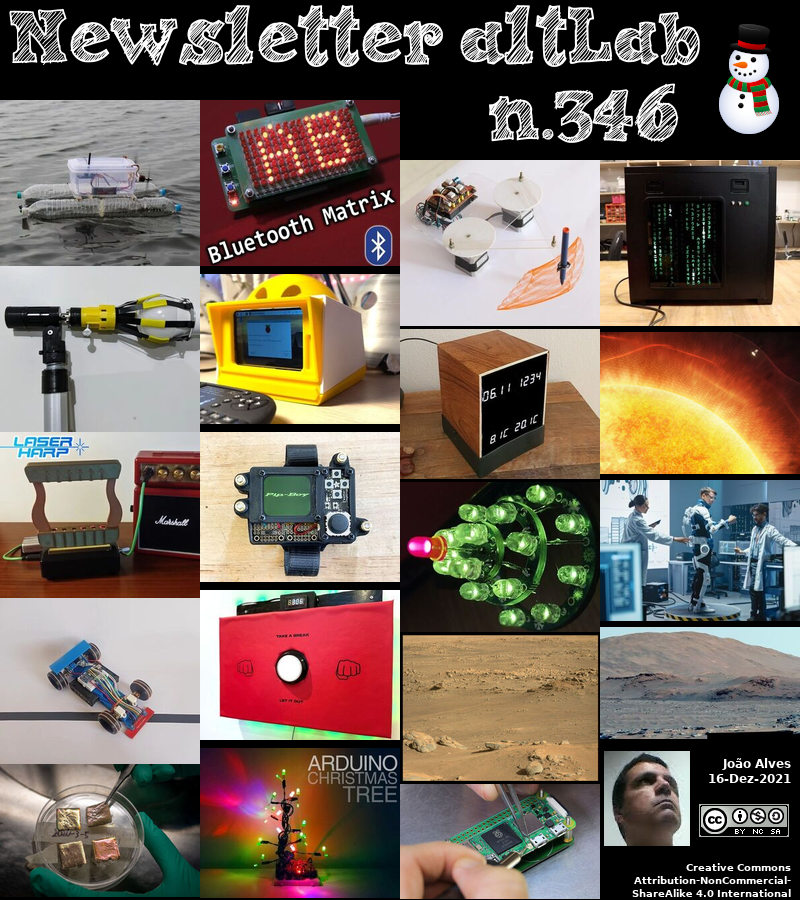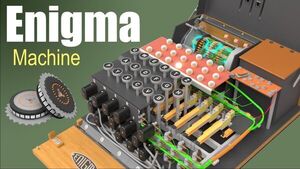2021-12-16 - Nº 346
Editorial
Esta é a Newsletter Nº 346 que se apresenta com o mesmo formato que as anteriores. Se gostar da Newsletter partilhe-a!
Todas as Newsletters encontram-se indexadas no link.
Esta Newsletter tem os seguintes tópicos:
Faz hoje anos que nascia, em 1776, o físico alemão Johann Wilhelm Ritter. Ele descobriu a região ultravioleta do espectro (1801) e assim ajudou a alargar a visão do homem para além da região estreita da luz visível para abranger todo o espectro electromagnético desde os raios gama mais curtos até às ondas de rádio mais longas. Após estudar a descoberta da radiação infravermelha pelo Herschel, observou os efeitos da radiação solar sobre os sais de prata e deduziu a existência de radiação fora do espectro visível. Também fez contribuições para a espectroscopia e para o estudo da electricidade.
Faz também hoje anos uqe nascia, em 1888, o engenheiro electrotécnico norte-americano Chester Williams Rice. Ele, juntamente com Edward W. Kellogg, inventou o altifalante de bobinas em movimento.
Por fim, faz hoje anos que nascia, em 1917, o escritor inglês de ficção científica Arthur C. Clarke. Co-escreveu o guião do filme de 1968: A Space Odyssey, um dos filmes mais influentes de todos os tempos. Clarke foi um escritor de ficção científica, um ávido popularizador das viagens espaciais, e um futurista de uma habilidade distinta. Ele escreveu muitos livros e muitos ensaios para revistas populares. Em 1961, recebeu o Prémio Kalinga, um prémio da UNESCO para a popularização da ciência. Os seus escritos de ciência e ficção científica de Clarke valeram-lhe o moniker "Profeta da Era Espacial". Os seus escritos de ficção científica, em particular, valeram-lhe uma série de prémios Hugo e Nebula, que juntamente com um grande número de leitores, fizeram dele uma das figuras mais importantes do género. Durante muitos anos Clarke, Robert Heinlein, e Isaac Asimov foram conhecidos como os "Três Grandes" da ficção científica. Clarke foi um defensor das viagens espaciais. Em 1934, ainda adolescente, entrou para o BIS, British Interplanetary Society. Em 1945, propôs um sistema de comunicação por satélite utilizando órbitas geoestacionárias. Foi presidente da British Interplanetary Society de 1946 a 1947 e novamente em 1951-1953.
Nesta semana que passou e pela primeira vez na história, uma nave espacial tocou o Sol. A Sonda Solar Parker da NASA voou agora através da atmosfera superior do Sol - a coroa - e aí recolheu amostras de partículas e campos magnéticos. O novo marco assinala um passo importante para a Sonda Parker Solar e um salto gigantesco para a ciência solar. Tal como aterrar na Lua permitiu aos cientistas compreender como foi formada, tocar no próprio material de que o Sol é feito ajudará os cientistas a descobrir informações críticas sobre a nossa estrela mais próxima e a sua influência sobre o sistema solar.
Na Newsletter desta semana apresentamos diversas noticias, artigos científicos, projetos de maker assim como alguns videos interessantes. É apresentada a revista MagPi nº 113 de Dezembro. Aproveito para desejar a todos votos de Boas Festas.
 João Alves ([email protected])
João Alves ([email protected])
O conteúdo da Newsletter encontra-se sob a licença  Creative Commons Attribution-NonCommercial-ShareAlike 4.0 International License.
Creative Commons Attribution-NonCommercial-ShareAlike 4.0 International License.
Novidades da Semana

NASA Enters the Solar Atmosphere for the First Time, Bringing New Discoveries
"For the first time in history, a spacecraft has touched the Sun. NASA’s Parker Solar Probe has now flown through the Sun’s upper atmosphere – the corona – and sampled particles and magnetic fields there. The new milestone marks one major step for Parker Solar Probe and one giant leap for solar science. Just as landing on the Moon allowed scientists to understand how it was formed, touching the very stuff the Sun is made of will help scientists uncover critical information about our closest star and its influence on the solar system. "Parker Solar Probe “touching the Sun” is a monumental moment for solar science and a truly remarkable feat," said Thomas Zurbuchen, the associate administrator for the Science Mission Directorate at NASA Headquarters in Washington. "Not only does this milestone provide us with deeper insights into our Sun's evolution and its impacts on our solar system, but everything we learn about our own star also teaches us more about stars in the rest of the universe.” As it circles closer to the solar surface, Parker is making new discoveries that other spacecraft were too far away to see, including from within the solar wind – the flow of particles from the Sun that can influence us at Earth." [...]
Outras Notícias
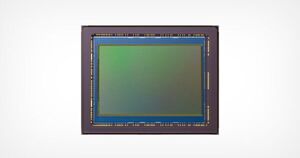
Sony Develops World’s First Stacked CMOS Image Sensor Technology with 2-Layer Transistor Pixel
"Sony Semiconductor Solutions Corporation (“Sony”) has succeeded in developing the world’s first*1 stacked CMOS image sensor technology with 2-Layer Transistor Pixel. Whereas conventional CMOS image sensors’ photodiodes and pixel transistors occupy the same substrate, Sony’s new technology separates photodiodes and pixel transistors on different substrate layers. This new architecture approximately doubles*2 saturation signal level*3 relative to conventional image sensors, widens dynamic range and reduces noise, thereby substantially improving imaging properties. The new technology’s pixel structure will enable pixels to maintain or improve their existing properties at not only current but also smaller pixel sizes. Sony announced this breakthrough at the IEEE International Electron Devices Meeting that started on Saturday, December 11, 2021. A stacked CMOS image sensor adopts a stacked structure consisting of a pixel chip made up of back-illuminated pixels stacked atop a logic chip where signal processing circuits are formed." [...]

NASA’s Ingenuity Mars Helicopter Reaches a Total of 30 Minutes Aloft
"With its recent 17th flight, the Red Planet rotorcraft reaches an airborne milestone the team never considered achievable. Its 18th flight is scheduled for no earlier than today. The 17th flight of NASA’s Ingenuity Mars Helicopter on Dec. 5 pushed the total flight time past the 30-minute mark. The 117-second sortie brought history’s first aircraft to operate from the surface of another world closer to its original airfield, “Wright Brothers Field,” where it will await the arrival of the agency’s Perseverance Mars rover, currently exploring “South Séítah” region of Mars’ Jezero Crater. Along with accumulating 30 minutes and 48 seconds of flight time, the trailblazing helicopter has traveled over the surface a distance of 2.2 miles (3,592 meters), flying as high as 40 feet (12 meters) and as fast as 10 mph (5 meters per second). The rotorcraft’s status after the Dec. 5 flight was previously unconfirmed due to an unexpected cutoff to the in-flight data stream as the helicopter descended toward the surface at the conclusion of its flight." [...]

Toshiba’s New 4-Form-A, Voltage Driven Photorelays Have One of Industry’s Smallest Mounting Areas, Will Help Reduce Semiconductor Tester Sizes
"Toshiba Electronic Devices & Storage Corporation ("Toshiba") has launched three 4-Form-A voltage driven photorelays, “TLP3407SRA4,” ”TLP3412SRHA4,” and “TLP3475SRHA4,“ that have one of the smallest[1] mounting areas in the industry. Volume shipments start today. The new products are Toshiba’s first-ever four-circuit, 4-Form-A relays. Housed in a newly-developed small S-VSON16T package, they feature a typical mounting area of 12.5mm2, one of the industry’s smallest[1]. By incorporating resistors at the input side, the products are made to be driven by voltage without any need for external resistors. These features help to reduce space requirements on circuit boards, allowing more photorelays to be mounted." [...]
IBM and Samsung Unveil Semiconductor Breakthrough That Defies Conventional Design
"Today, IBM (NYSE: IBM) and Samsung Electronics jointly announced a breakthrough in semiconductor design utilizing a new vertical transistor architecture that demonstrates a path to scaling beyond nanosheet, and has the potential to reduce energy usage by 85 percent compared to a scaled fin field-effect transistor (finFET)1. The global semiconductor shortage has highlighted the critical role of investment in chip research and development and the importance of chips in everything from computing, to appliances, to communication devices, transportation systems, and critical infrastructure. This collaborative approach to innovation makes the Albany Nanotech Complex a world-leading ecosystem for semiconductor research and creates a strong innovation pipeline, helping to address manufacturing demands and accelerate the growth of the global chip industry. The new vertical transistor breakthrough could help the semiconductor industry continue its relentless journey to deliver significant improvements, including: - Potential device architecture that enables semiconductor device scaling to continue beyond nanosheet. - Cell phone batteries that could go over a week without being charged, instead of days. - Energy intensive processes, such as cryptomining operations and data encryption, could require significantly less energy and have a smaller carbon footprint." [...]
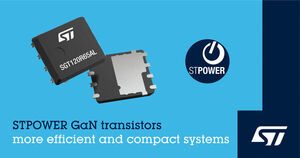
STMicroelectronics Introduces First PowerGaN Products for More Energy-Efficient, Slimmer Power Supplies
"STMicroelectronics (NYSE: STM), a global semiconductor leader serving customers across the spectrum of electronics applications, has revealed a new family of GaN power semiconductors in the STPOWER portfolio that can significantly reduce energy use and enable slimmer designs in a huge variety of electronic products. Target applications include consumer equipment such as chargers, external power adapters for PCs, LED-lighting drivers, and power supplies inside televisions and home appliances. This equipment is produced in high volumes worldwide and, with greater efficiency, can realize significant CO2 savings. In higher-power applications, ST’s PowerGaN devices also benefit telecom power supplies, industrial motor drives, solar inverters, and electric vehicles and chargers. “Commercializing GaN-based products is the next frontier for power semiconductors, and we are ready to realize the potential of this exciting technology. Today ST is announcing the first product in a new family, belonging to the STPOWER portfolio, that can deliver breakthrough performance for a large variety of power supplies across consumer, industrial, and automotive applications,” said Edoardo Merli, Power Transistor Macro-Division General Manager and Group Vice President of STMicroelectronics’ Automotive and Discrete Group." [...]
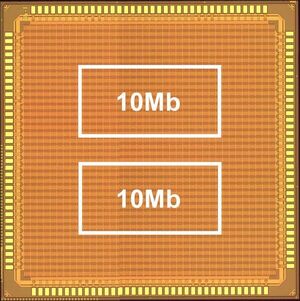
Renesas Develops Write Technologies for Embedded STT-MRAM Significantly Reducing MCUs Power Consumption in IoT Applications
"Renesas Electronics Corporation (TSE:6723), a premier supplier of advanced semiconductor solutions, today announced the development of two technologies that reduce the energy and voltage application time for the write operation of spin-transfer torque magnetic random-access memory (STT-MRAM, hereinafter MRAM). On a 20-megabit (Mbit) test chip with embedded MRAM memory cell array in a 16 nm FinFET logic process, a 72 percent reduction in write energy and a 50 percent reduction in the voltage application time were confirmed. The new technologies are: 1) A self-termination write scheme with slope pulse application, in which the write pulse is automatically and adaptively terminated due to write characteristics of each memory cell; 2) A write sequence to optimize the number of bits, to which write voltage is applied simultaneously. Combined, these technologies make it possible to reduce the power consumption and increase the speed of write operations. Renesas presented these achievements on December 13 at the 2021 IEEE International Electron Devices Meeting (IEDM), held between December 11 and 15 in San Francisco. With the accelerated spread of IoT technology in recent years, there has been strong demand for reduced power consumption in microcontroller units (MCUs) used in endpoint devices." [...]

NASA’s Perseverance Mars Rover Makes Surprising Discoveries
"The findings by rover scientists highlight the diversity of samples geologists and future scientists associated with the agency’s Mars Sample Return program will have to study. Scientists with NASA’s Perseverance Mars rover mission have discovered that the bedrock their six-wheeled explorer has been driving on since landing in February likely formed from red-hot magma. The discovery has implications for understanding and accurately dating critical events in the history of Jezero Crater – as well as the rest of the planet. The team has also concluded that rocks in the crater have interacted with water multiple times over the eons and that some contain organic molecules. These and other findings were presented today during a news briefing at the American Geophysical Union fall science meeting in New Orleans. Even before Perseverance touched down on Mars, the mission’s science team had wondered about the origin of the rocks in the area." [...]

Renesas Introduces Second-Generation of ClockMatrix Family of Network Synchronizers and Jitter Attenuators for Optical and Wireline Networks
"Renesas Electronics Corporation (TSE:6723), a premier supplier of advanced semiconductor solutions, today introduced the ClockMatrix 2 high-performance, precision, multi-channel timing devices for 400/800Gbps optical transport and wireline network applications. Building on the ClockMatrix devices introduced in 2019 for 5G wireless and 100/200Gbps wireline network applications, the second-generation family delivers improved performance with phase jitter as low as 88fs-rms. The highly integrated devices provide all the functionality needed to implement an IEEE1588 clock solution with jitter attenuation capabilities resulting in ultra-low jitter clock outputs for Synchronous Ethernet PHYs with data rates up to 112Gbps PAM-4, reducing design complexity and bill of materials (BOM) requirements, while also allowing customers to apply the timing devices to a wide variety of network applications. “The shift to 5G is pushing the limits of network speed and precision, raising the bar on clock jitter and synchronization capabilities,” said Bobby Matinpour, Vice President of the Timing Products Division at Renesas. “The new ClockMatrix 2 family delivers on all fronts, with low jitter, high precision, and a wide range of synchronization features in a highly integrated single-chip solution.” Key Features of the ClockMatrix 2 Family - Highly integrated, 6-channel precision timing source that eliminates the need for additional jitter attenuators for high-speed interfaces - 88fs-rms phase jitter on clock outputs to support ultra-low jitter clock outputs for high-speed serial links (up to 112Gbps PAM-4 PHYs) - Supports multiple standards and protocols including synchronous Ethernet (Sync-E), and IEEE1588 - Adherence to G.8262.1 and G.8262 telecom boundary clock requirements and G.8273.2 Class C and Class D time accuracy The ClockMatrix 2 system synchronizer can be combined with Renesas’ complementary analog and power offerings to create comprehensive solutions for a variety of applications. For example, ClockMatrix 2 is integrated into the 200/400/800Gbps Fixed Form Factor Switch Solution Winning Combination, along with analog and power offerings from Renesas." [...]

MediaTek Officially Launches Dimensity 9000 Flagship Chip And Announces Adoption by Global Device Makers
"Built on the leading TSMC N4 process, Dimensity 9000 brings full flagship performance and power-efficiency to smartphones. First MediaTek powered devices will be available in Q1 of 2022 MediaTek today launched its Dimensity 9000 5G smartphone chip for next-generation flagship smartphones, and announced device maker adoption and endorsements from some of the world’s biggest smartphone brands, including OPPO, vivo, Xiaomi and Honor. The first Dimensity 9000 powered flagship smartphones will be in the market in the first quarter of next year. The Dimensity 9000 - the world’s first smartphone built on the ultra-efficient TMSC N4 (4nm-class) production process - leads the industry in computing performance, gaming, imaging, multimedia and connectivity innovations. “The Dimensity 9000 is a milestone for MediaTek, highlighting our rise to incredible with a true flagship 5G smartphone chip. This chip signals MediaTek and our Dimensity family has entered a new phase of innovation,” said Dr. Yenchi Lee, Deputy General Manager of MediaTek’s Wireless Communications Business Unit." [...]

Samsung Begins Mass Production of Comprehensive Automotive Memory Solutions for Next-Generation Autonomous Electric Vehicles
"Samsung Electronics, the world leader in advanced memory technology, today unveiled an extensive lineup of cutting-edge automotive memory solutions designed for next-generation autonomous electric vehicles. The new lineup includes a 256-gigabyte (GB) PCIe Gen3 NVMe ball grid array (BGA) SSD, 2GB GDDR6 DRAM and 2GB DDR4 DRAM for high-performance infotainment systems, as well as 2GB GDDR6 DRAM and 128GB Universal Flash Storage (UFS) for autonomous driving systems. “With the recent proliferation of electric vehicles and the rapid advancement of infotainment and autonomous driving systems, the semiconductor automotive platform is facing a paradigm shift. What used to be a seven to eight-year replacement cycle is now being compressed into a three to four-year cycle, and at the same time, performance and capacity requirements are advancing to levels commonly found in servers,” said Jinman Han, Executive Vice President and Head of Memory Global Sales & Marketing at Samsung Electronics. “Samsung’s reinforced lineup of memory solutions will act as a major catalyst in further accelerating the shift toward the ‘Server on Wheels’ era.” Advanced features in infotainment systems such as high-definition maps, video streaming and 3D gaming, together with the growing use of autonomous driving systems, have been driving the demand for high-capacity, high-performance SSDs and graphics DRAM throughout the automotive industry. In 2017, Samsung was the first in the industry to introduce UFS solutions for automotive applications." [...]
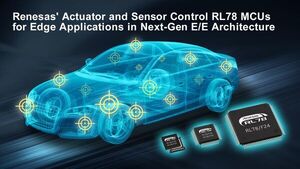
Renesas Launches Automotive Actuator and Sensor Control MCUs for Evolving Edge Applications in Next-Generation E/E Architecture
"Renesas Electronics Corporation (TSE:6723), a premier supplier of advanced semiconductor solutions, today announced two new microcontrollers (MCUs) designed for automotive actuator and sensor control applications supporting edge evolution in next-generation electronic and electrical (E/E) architecture. With the new RL78/F24 and RL78/F23, Renesas expands its RL78 Family of low-power 16-bit MCUs and strengthens its broader automotive portfolio, offering customers highly reliable, high-performance solutions for systems ranging from actuators to zone control. With E/E architecture extending to include zone and domain control applications, control mechanisms are evolving to accommodate body control for automotive systems such as lights, windows, and mirrors; motor control for engine pumps and fans; and multiple sensor control. Moving forward, high-speed and secure connectivity with zone and domain controllers will be mission critical for edge electronic control units (ECUs). Renesas’ next-generation RL78/F24 and RL78/F23 MCUs address changing technology demands for actuator and sensor control with enhanced security, rich connectivity, and functional safety capabilities. The new devices support the CAN FD high-speed communication protocol (RL78/F24) and EVITA-Light security and are optimized for systems targeting ASIL-B levels under the ISO 26262 functional safety standard." [...]

Hyundai Motor Group Reveal Mobile Eccentric Droid (MobED)
"Hyundai Motor Group (the Group) today revealed the Mobile Eccentric Droid (MobED), an all-new and pioneering small mobility platform using cutting-edge robotics technologies. The MobED has an innovative design arrangement. It’s flat, rectangular body rides on four large wheels, with an independent suspension that enables optimal body posture and stable movement even on inclined and uneven roads. This suspension allows the platform to move through complex urban environments by freely adjusting its wheelbase and steering angles. “We have developed the MobED platform to overcome the limitations of existing indoor guide and service robots while maximizing its usability in cities by dramatically improving the platform’s overall mobility,” said Dong Jin Hyun, Head of Hyundai Motor Group Robotics Lab. “We are also looking ahead to assess how potential users of MobED will further expand their needs and use for this type of technology.” By being equipped with innovative technologies including an advanced ‘Eccentric Wheel’ drive and high-tech steering, braking and altitude control systems, the MobED adapts and realizes optimum posture on various road surfaces and environments." [...]
Ciência e Tecnologia
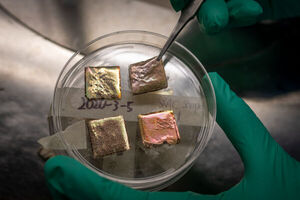
New Smart-Roof Coating Enables Year-Round Energy Savings
"Breakthrough regulates household temperature without consuming natural gas or electricity. Scientists have developed an all-season smart-roof coating that keeps homes warm during the winter and cool during the summer without consuming natural gas or electricity. Research findings reported in the journal Science point to a groundbreaking technology that outperforms commercial cool-roof systems in energy savings. “Our all-season roof coating automatically switches from keeping you cool to warm, depending on outdoor air temperature. This is energy-free, emission-free air conditioning and heating, all in one device,” said Junqiao Wu, a faculty scientist in Berkeley Lab’s Materials Sciences Division and a UC Berkeley professor of materials science and engineering who led the study. Today’s cool roof systems, such as reflective coatings, membranes, shingles, or tiles, have light-colored or darker “cool-colored” surfaces that cool homes by reflecting sunlight." [...]

Invisible Material: Researchers Model Metasurfaces in Hybrid Anapole Modes for the First Time
"Global trends are leaning towards miniaturization, minimalism, and portability – and that's the case for research, too. These days, metasurfaces are gaining popularity as platforms for super-thin devices equal, or sometimes superior to, their "normal-sized" counterparts. This is achieved thanks to “invisible” particles in anapole modes. Recently, these particles have nanophotonics, but researchers from ITMO, Moscow, and Riga went even further and developed hybrid anapole modes. Their new model is more efficient than its predecessors and opens new applications for metasurfaces in optics. So meta Just like some substances are made up of atoms, metasurfaces consist of metaatoms." [...]

Picture perfect X-ray capture
"Layered nanomaterials shine for lossless light-energy conversion. A nanocomposite that absorbs X-rays and then, with nearly perfect efficiency, re-emits the captured energy as light, could help to improve high-resolution medical imaging and security screening. The material’s near-100 percent energy transfer could bring efficiency gains in devices ranging from light-emitting diodes (LEDs) and X-ray imaging scintillators, all the way to solar cells1. During a medical imaging procedure, X-rays passing through the body are absorbed by a scintillator material, which converts X-rays into light for a digital camera type sensor to capture. “To date, high-performance scintillators consist mainly of either ceramic that needs harsh and costly preparation conditions, or perovskite materials that have poor air and light stability and high toxicity,” says Jian-Xin Wang, a postdoc in Omar Mohammed's lab who led the work. Organic scintillator materials, in contrast, have good processability and stability but low imaging resolution and detection sensitivity due to the low atomic weight — and so limited X-ray absorption — of their component atoms." [...]

Giving bug-like bots a boost
"A new fabrication technique produces low-voltage, power-dense artificial muscles that improve the performance of flying microrobots. When it comes to robots, bigger isn’t always better. Someday, a swarm of insect-sized robots might pollinate a field of crops or search for survivors amid the rubble of a collapsed building. MIT researchers have demonstrated diminutive drones that can zip around with bug-like agility and resilience, which could eventually perform these tasks. The soft actuators that propel these microrobots are very durable, but they require much higher voltages than similarly-sized rigid actuators. The featherweight robots can’t carry the necessary power electronics that would allow them fly on their own." [...]

New copper surface eliminates bacteria in just two minutes
"A new surface that kills bacteria more than 100 times faster and more effectively than standard copper could help combat the growing threat of antibiotic-resistant superbugs. The new copper product is the result of a collaborative research project with RMIT University and Australia’s national science agency, CSIRO, with findings just published in Biomaterials. Copper has long been used to fight different strains of bacteria, including the commonly found golden staph, because the ions released from the metal’s surface are toxic to bacterial cells. But this process is slow when standard copper is used, as RMIT University’s Distinguished Professor Ma Qian explained, and significant efforts are underway by researchers worldwide to speed it up. “A standard copper surface will kill about 97% of golden staph within four hours,” Qian said. “Incredibly, when we placed golden staph bacteria on our specially-designed copper surface, it destroyed more than 99.99% of the cells in just two minutes.” “So not only is it more effective, it’s 120 times faster.” Importantly, said Qian, these results were achieved without the assistance of any drug." [...]

Super-bright stellar explosion is likely a dying star giving birth to a black hole or neutron star
"The discovery, based on an unusual event dubbed “the Cow,” may offer astronomers a new way to spot infant compact objects. In June of 2018, telescopes around the world picked up a brilliant blue flash from the spiral arm of a galaxy 200 million light years away. The powerful burst appeared at first to be a supernova, though it was much faster and far brighter than any stellar explosion scientists had yet seen. The signal, procedurally labeled AT2018cow, has since been dubbed simply “the Cow,” and astronomers have catalogued it as a fast blue optical transient, or FBOT — a bright, short-lived event of unknown origin. Now an MIT-led team has found strong evidence for the signal’s source. In addition to a bright optical flash, the scientists detected a strobe-like pulse of high-energy X-rays." [...]

New Crystal Structure for Hydrogen Compounds for High-Temperature Superconductivity
"Superconductivity is the disappearance of electrical resistance in certain materials below a certain temperature, known as "transition temperature." The phenomenon has tremendous implications for revolutionizing technology as know it, enabling low-loss power transmission and maintenance of electromagnetic force without electrical supply. However, superconductivity usually requires extremely low temperatures ~ 30 K (the temperature of liquid nitrogen, in comparison, is 77 K) and, therefore, expensive cooling technology. To have a shot at realizing a low-cost superconducting technology, superconductivity must be achieved at much higher transition temperatures. Materials scientists have had a breakthrough on this front with crystalline materials containing hydrogen, known as "metal hydrides." These are compounds formed by a metal atom bonded with hydrogen that have been predicted and realized as suitable candidates for achieving even room-temperature superconductivity." [...]

Driverless cars a step closer to our roads with new self-learning AI technology
"Computer scientists from Lancaster University have developed new AI technology that takes autonomous cars a step closer to our roads. Funded by global car manufacturer Ford, the three-year research project provides a step-change in AI car technology by enabling autonomous cars to recognise new and unexpected situations. Around the world, many different automotive brands, computing companies, and research teams, are developing autonomous car technologies and many of these are using a machine learning technique called ‘Deep Learning’. Deep Learning works by recognising patterns after the computer system has been shown a large number of different training examples. However, a fundamental drawback with Deep Learning algorithms is that they are unable to recognise scenarios that differ significantly from training examples and, unlike humans, they are incapable of exploring, improving and improvising. On the road, Deep Learning’s lack of situational awareness has led to life-threatening situations." [...]

Lanthanoids offer great potential
"In a special issue of Nature Physics, Francesca Ferlaino and Matthew Norcia highlight the great potential of ultracold quantum gases from lanthanides. Despite their complexity, they are comparatively easy to access for experimental research and offer a wide range of possibilities for basic research and application. A quarter of a century after the first creation of Bose-Einstein condensates, the journal Nature Physics publishes a focus issue on developments in the field of ultracold quantum gases and their potential in the future. For example, in what direction will atomic microscopes, optical tweezers, or new laser traps develop? What potential lies in quantum gases from lanthanides has been detailed by Francesca Ferlaino and Matthew Norcia from the Department of Experimental Physics at the University of Innsbruck and the Institute of Quantum Optics and Quantum Information of the Austrian Academy of Sciences in a review article in the special issue. When ultracold quantum gases were started to be condensed three decades ago, simple particles from the group of alkali or alkaline earth atoms, with only one or two electrons in their outer shells, such as lithium or rubidium, were chosen for this purpose." [...]
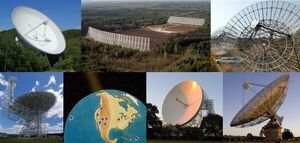
Challenging Einstein’s greatest theory with extreme stars
"Researchers at The University of Manchester have helped conduct a 16-year long experiment to challenge Einstein’s theory of general relativity. The international team including scientists from; the Max Planck Insitute, The University of British Columbia and The University of East Anglia looked to the stars - a pair of extreme stars called pulsars to be precise – through seven radio telescopes across the globe. And they used them to challenge Einstein’s most famous theory with some of the most rigorous tests yet. The study, published today in the journal Physical Review X, reveals new relativistic effects that, although expected, have now been observed for the first time. Emeritus Professor at The University of Manchester Andrew Lyne, said: "The discovery of the double pulsar system was made as part of a survey co-led from The University of Manchester and presented us with the only known instance of two cosmic clocks which allow precise measurement of the structure and evolution of an intense gravitational field. “The Lovell Telescope at the Jodrell Bank Observatory has been monitoring it every couple of weeks since then." [...]

Why becoming a bionic superhuman would be more trouble than it's worth... for now!
"Once-futuristic bionic devices are now a reality, but UNSW expert Dr Michael Stevens says we’re not yet living in a world as portrayed in films and on TV. Did you ever dream of one day having X-ray vision or running as fast as a cheetah? Maybe you’ve imagined the benefits of lifting a car with just one hand, or being able to hear the sound of an ant’s footsteps. Science-fiction books, TV series and movies have often explored the idea of individuals gaining superhuman powers thanks to medical implants – think the Bionic Woman, or the Six Million Dollar Man. But many bionic devices that were once considered ‘futuristic’ are already a reality – hands, arms, legs, ears and even hearts and eyes can now be replicated and replaced in the body with mechanical versions. However, UNSW Sydney’s Dr Michael Stevens says the truth is far from science fiction for most people with bionic implants." [...]
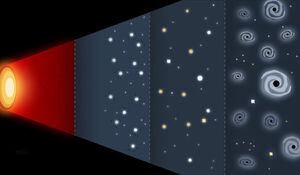
Black holes and dark matter — are they one and the same?
"Primordial black holes created in the first instants after the Big Bang — tiny ones smaller than the head of a pin and supermassive ones covering billions of miles — may account for all of the dark matter in the universe. That’s the implication of a new model of the early universe created by astrophysicists at Yale, the University of Miami, and the European Space Agency (ESA). If proven true with data from the soon-to-launch James Webb Space Telescope, the discovery would transform scientists’ understanding of the origins and nature of both dark matter and black holes. Dark matter — which has never been directly observed — is thought to constitute the majority of matter in the universe and act as the unseen scaffolding upon which galaxies form and develop. Physicists have spent years testing a variety of dark matter candidates, including hypothetical particles such as sterile neutrinos, Weakly Interacting Massive Particles (WIMPS), and axions. Black holes, on the other hand, have been observed." [...]
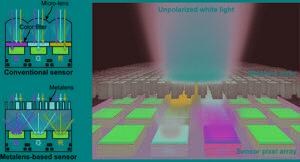
Color-Sorting Metalenses Boost Imaging Sensitivity
"Technology advance enables filter-free imaging sensors that are poised to improve low-light and fast imaging for smartphones and autonomous vehicles Researchers have shown that newly designed pixel-scale metasurface lenses — flat surfaces that use nanostructures to manipulate light — can be used to make imaging sensors that are roughly three times more sensitive than those used today. The new sensor architecture could enable digital cameras that can image faster or in conditions with less light. “Traditional imaging sensors such as the ones used in smartphones, wearable devices and autonomous vehicles have a limited sensitivity because they rely on color filters placed over each pixel,” said research team leader Masashi Miyata from NTT Device Technology Labs in Japan. “Our new metalenses are made from a highly-engineered surface that can collect light while simultaneously separating primary colors without any color filters, opening a pathway to dramatically improve sensitivity.” In Optica, Optica Publishing Group’s journal for high-impact research, Miyata and colleagues report that filter-free color sensors made with the new metalenses significantly enhanced signal levels without sacrificing color image quality or spatial resolution. And because the new metalenses are made using a CMOS-compatible process, they could easily be integrated onto current sensors to create filter-free imaging devices. “We envision our metalenses playing an important role in the development of filter-free color image sensors that exceed current sensitivity limits,” said Miyata." [...]
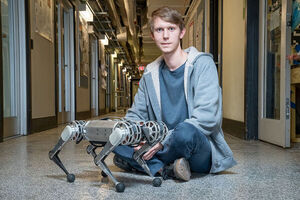
From “cheetah-noids” to humanoids
"In November 2018, MIT Professor Sangbae Kim brought his mini cheetah robot onto “The Tonight Show’s” Tonight Show-botics segment. Much to the delight of host Jimmy Fallon, the mini cheetah did some yoga, got back up after falling, and executed a perfect backflip. Behind the stage, Benjamin Katz '16, SM '18 was remotely controlling the cheetah’s nimble maneuvers. For Katz, waiting in the wings as the robot performed in front of a national audience was the culmination of nearly five years of work. As an undergraduate at MIT, Katz studied mechanical engineering, opting for the flexible Course 2A degree program with a concentration in controls, instrumentation, and robotics. Toward the end of his first year, he emailed Kim to see if there were any job opportunities in Kim’s Biomimetic Robotics Lab." [...]
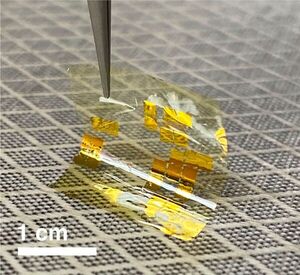
New solar materials developed by Stanford scientists could usher in ultrathin, lightweight solar panel
"New, ultrathin photovoltaic materials could eventually be used in mobile applications, from self-powered wearable devices and sensors to lightweight aircraft and electric vehicles. A race is on in solar engineering to create almost impossibly-thin, flexible solar panels. Engineers imagine them used in mobile applications, from self-powered wearable devices and sensors to lightweight aircraft and electric vehicles. Against that backdrop, researchers at Stanford University have achieved record efficiencies in a promising group of photovoltaic materials. Chief among the benefits of these transition metal dichalcogenides – or TMDs – is that they absorb ultrahigh levels of the sunlight that strikes their surface compared to other solar materials. “Imagine an autonomous drone that powers itself with a solar array atop its wing that is 15 times thinner than a piece of paper,” said Koosha Nassiri Nazif, a doctoral scholar in electrical engineering at Stanford and co-lead author of a study published in the Dec. 9 edition of Nature Communications." [...]
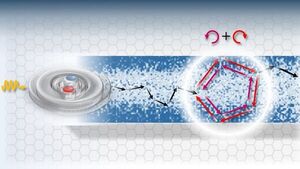
"Crazy" Light Emitters: Physicists See An Unusual Quantum Phenomenon
"Scientists of the Cluster of Excellence ct.qmat–Complexity and Topology in Quantum Matter have experimentally confirmed an unusual quantum phenomenon for the motion of luminescent electronic quasiparticles in atomically-thin semiconductors. The results were published in the Physical Review Letters journal. A highly unusual movement of light emitting particles in atomically-thin semiconductors was experimentally confirmed by scientists from the Würzburg–Dresden Cluster of Excellence ct.qmat–Complexity and Topology in Quantum Matter. Electronic quasiparticles, known as excitons, seemed to move in opposite directions at the same time. Professor Alexey Chernikov–newly appointed physicist at the Technische Universität Dresden–and his team were able to reveal the consequences of this quantum phenomenon by monitoring light emission from mobile excitons using ultrafast microscopy at extremely low temperatures. These findings move the topic of quantum transport of excitonic many-body states into the focus of modern research." [...]
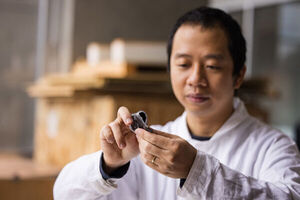
Stretchy, washable battery brings wearable devices closer to reality
"UBC researchers have created what could be the first battery that is both flexible and washable. It works even when twisted or stretched to twice its normal length, or after being tossed in the laundry. “Wearable electronics are a big market and stretchable batteries are essential to their development,” says Dr. Ngoc Tan Nguyen (he/him), a postdoctoral fellow at UBC’s faculty of applied science. “However, up until now, stretchable batteries have not been washable. This is a critical addition if they are to withstand the demands of everyday use.” The battery developed by Dr. Nguyen and his colleagues offers a number of engineering advances. In normal batteries, the internal layers are hard materials encased in a rigid exterior." [...]
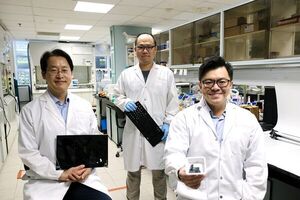
Giving e-waste plastics a new lease of life
"Plastics found in electronic waste (e-waste) are rarely recycled due to their complex composition and hazardous additives, but scientists at NTU Singapore have developed a new use for them – by repurposing them as an alternative to the plastics used in laboratory cell culture containers, such as petri dishes. The team at NTU Singapore–CEA Alliance for Research in Circular Economy (SCARCE) repurposed the e-waste plastics, subjecting them only to sterilisation, before being trialled in lab experiments. The team found that over 95 per cent of the human stem cells seeded on plastics scavenged from discarded computer components remained healthy after a week, a result comparable to cells grown on conventional cell culture plates. These findings, described in a study published online in the scientific journal Science of the Total Environment, indicate a potential new sustainable use for e-waste plastics, which account for about 20 per cent of the 50 million tonnes of e-waste produced worldwide each year. Repurposing them for cell culture in the lab would not only allow maximum value to be recovered from e-waste plastics, but also help to reduce the amount of plastic waste generated from biomedical research, said the NTU research team. A study in 2015 estimated that 5.5 million tonnes of lab-related plastic waste , including cell culture dishes, is generated globally in a year." [...]

N-type Conductive Tin Sulfide Thin Films: Towards Environmentally Friendly Solar Cells
"Tin sulfide (SnS) is an abundant, safe, and environmentally friendly solar cell material. This inexpensive material is forecast to be used in next-generation solar cell panels. A research group led by Issei Suzuki and Sakiko Kawanishi, assistant professors at Tohoku University's Institute of Multidisciplinary Research for Advanced Materials, has fabricated n-type conductive SnS thin films by impurity doping for the first time. Conventional SnS thin films are usually p-type conductive. Thus, SnS thin-film solar cells have been fabricated using a pn heterojunction with p-type SnS thin film and other n-type semiconductor thin films, such as CdS. However, the conversion efficiency of such heterojunction devices has stagnated at approximately 5%, rendering their use impractical." [...]
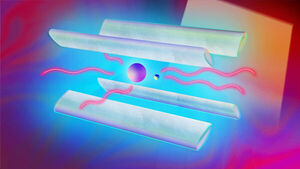
Quantum algorithms bring ions to a standstill
"Laser beams can do more than just heat things up; they can cool them down too. That is nothing new for physicists who have devoted themselves to precision spectroscopy and the development of optical atomic clocks. But what is new is the extremely low temperature that researchers at the QUEST Institute at the Physikalisch-Technische Bundesanstalt (PTB) have been able to reach with their highly charged ions – this type of ion has never been cooled down as far as 200 µK before. The team working on this succeeded by combining their established methods which include the laser cooling of coupled ions and methods from the field of quantum computing. The application of quantum algorithms ensured that ions that are too dissimilar for traditional laser cooling to work effectively could be cooled down together after all. This means that we are getting closer to an optical atomic clock with highly charged ions, and this clock might have the potential to be even more accurate than existing optical atomic clocks." [...]
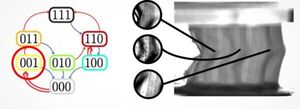
A computer made of floppy rubber
"A piece of corrugated rubber can function as a simple computer, displaying memory and displaying the ability to count to two. Leiden physicists describe the computing rubber in the journal PNAS. ‘Simple materials can process information, and we want to find the principles behind that.’ Where other physicists use telescopes, microscopes or particle accelerators to study their subjects, Martin van Hecke and Hadrien Bense just use pieces of rubber, which they fold and film. This way, they have proven that even an extremely simple material is able to perform some sort of information processing. Sudden popping A video by the researchers (both at Leiden University and AMOLF research institute in Amsterdam) shows a piece of corrugated rubber, slowly squashed from above using a press. First, the corrugations slowly bend along, but at a certain point, they snap, which means that they suddenly pop into another shape." [...]
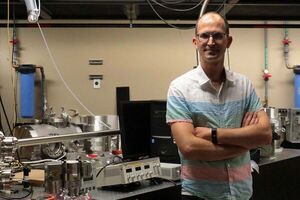
UCF Develops the World’s First Optical Oscilloscope
"The innovation could be a game-changer for communication technologies, such as phones and internet connections. Ateam from UCF has developed the world’s first optical oscilloscope, an instrument that is able to measure the electric field of light. The device converts light oscillations into electrical signals, much like hospital monitors convert a patient’s heartbeat into electrical oscillation. Until now, reading the electric field of light has been a challenge because of the high speeds at which light waves oscillates. The most advanced techniques, which power our phone and internet communications, can currently clock electric fields at up to gigahertz frequencies — covering the radio frequency and microwave regions of the electromagnetic spectrum. Light waves oscillate at much higher rates, allowing a higher density of information to be transmitted." [...]

Exotic six-quark particle predicted by supercomputers
"A new particle predicted by supercomputers could shed light on how matter is formed The predicted existence of an exotic particle made up of six elementary particles known as quarks by RIKEN researchers could deepen our understanding of how quarks combine to form the nuclei of atoms1. Quarks are the fundamental building blocks of matter. The nuclei of atoms consist of protons and neutrons, which are in turn made up of three quarks each. Particles consisting of three quarks are collectively known as baryons. Scientists have long pondered the existence of systems containing two baryons, which are known as dibaryons. Only one dibaryon exists in nature—deuteron, a hydrogen nucleus made up of a proton and a neutron that are very lightly bound to each other." [...]

Resolving the Puzzles of Graphene Superconductivity
"Physicists publish a theoretical framework to explain the recent discovery of superconductivity in trilayer graphene Since superconductivity in three-layered graphene was discovered in September, the physics community has been left puzzled. Now, three months later, physicists from IST Austria together with colleagues from the Weizmann Institute of Science can successfully explain the results by drawing from a theory of unconventional superconductivity. The work has been published in Physical Review Letters. A single layer of carbon atoms arranged in a honeycomb lattice makes up the promising nanomaterial called graphene. Research on a setup of three sheets of graphene stacked on top of one another so that their lattices are aligned but shifted — forming rhombohedral trilayer graphene – revealed an unexpected state of superconductivity. In this state electrical resistance vanishes due to the quantum nature of the electrons." [...]
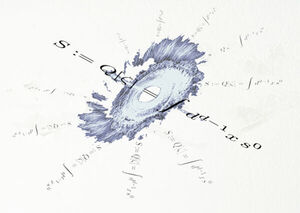
Einstein finally warms up to quantum mechanics?
"Einstein was no stranger to mathematical challenges. He struggled to define energy in a way that acknowledged both the law of energy conservation and covariance, which is general relativity's fundamental feature where physical laws are the same for all observers. A research team at Kyoto University's Yukawa Institute for Theoretical Physics has now proposed a novel approach to this longstanding problem by defining energy to incorporate the concept of entropy. Although a great deal of effort has gone into reconciling the elegance of general relativity with quantum mechanics, team member Shuichi Yokoyama says, "The solution is shockingly intuitive." Einstein's field equations describe how matter and energy shape spacetime and how in turn the structure of spacetime moves matter and energy. Solving this set of equations, however, is notoriously difficult, such as with pinning down the behavior of a charge associated with an energy-momentum tensor, the troublesome factor that describes mass and energy." [...]

Quantum theory needs complex numbers
"An international team of researchers shows through a concrete theoretical experiment that the prediction by standard complex quantum theory cannot be expressed by its real counterpart and ratifies its need of complex numbers. Their results have been published in Nature. Physicists construct theories to describe nature. Let us explain it through an analogy with something that we can do in our everyday life, like going on a hike in the mountains. To avoid getting lost, we generally use a map. The map is a representation of the mountain, with its houses, rivers, paths, etc." [...]
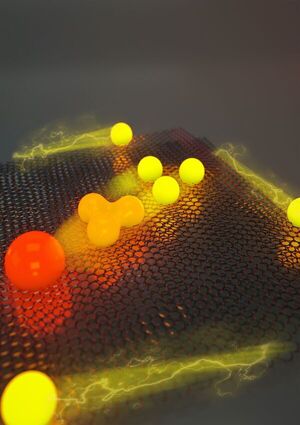
Exotic quantum particles — less magnetic field required
"Research paves the way for future quantum devices and applications Exotic quantum particles and phenomena are like the world’s most daring elite athletes. Like the free solo climbers who scale impossibly steep cliff faces without a rope or harness, only the most extreme conditions will entice them to show up. For exotic phenomena like superconductivity or particles that carry a fraction of the charge of an electron, that means extremely low temperatures or extremely high magnetic fields. But what if you could get these particles and phenomena to show up under less extreme conditions? Much has been made of the potential of room-temperature superconductivity, but generating exotic fractionally charged particles at low-to-zero magnetic field is equally important to the future of quantum materials and applications, including new types of quantum computing. Now, a team of researchers from Harvard University led by Amir Yacoby, Professor of Physics and of Applied Physics at the Harvard John A. Paulson School of Engineering and Applied Sciences (SEAS) and Ashvin Vishwanath, Professor of Physics in the Department of Physics, in collaboration with Pablo Jarillo-Herrero at the Massachusetts Institute of Technology, have observed exotic fractional states at low magnetic field in twisted bilayer graphene for the first time." [...]
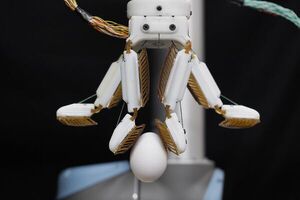
Stanford engineers develop a robotic hand with a gecko-inspired grip
"Aiming to create a robotic gripper that can grasp with delicate strength, researchers combine adhesives based on gecko toes with a customized robotic hand. Across a vast array of robotic hands and clamps, there is a common foe: the heirloom tomato. You may have seen a robotic gripper deftly pluck an egg or smoothly palm a basketball – but, unlike human hands, one gripper is unlikely to be able to do both and a key challenge remains hidden in the middle ground. “You’ll see robotic hands do a power grasp and a precision grasp and then kind of imply that they can do everything in between,” said Wilson Ruotolo, PhD ’21, a former graduate student in the Biomimetics and Dextrous Manipulation Lab at Stanford University. “What we wanted to address is how to create manipulators that are both dexterous and strong at the same time.” The result of this goal is “farmHand,” a robotic hand developed by engineers Ruotolo and Dane Brouwer, a graduate student in the Biomimetics and Dextrous Manipulation Lab, at Stanford (aka “the Farm”) and detailed in a paper published Dec. 15 in Science Robotics. In their testing, the researchers demonstrated that farmHand is capable of handling a wide variety of items, including raw eggs, bunches of grapes, plates, jugs of liquids, basketballs and even an angle grinder." [...]
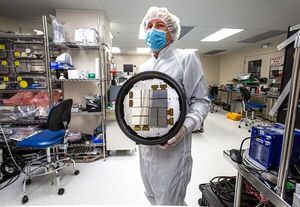
A versatile set of detector building blocks prepares SLAC researchers for a challenging future of X-ray science
"The ePix series of detectors is designed to keep pace with ever more demanding experiments at SLAC and elsewhere. When the Department of Energy’s SLAC National Accelerator Laboratory turned on the world’s first hard X-ray free-electron laser in 2009, it marked the beginning of a new era in science – one where researchers could directly observe the ultrafast motions of atoms in real time and study how those motions affect the properties of materials and fundamental processes in chemistry and biology. But the new machine, called the Linac Coherent Light Source (LCLS), also required a new breed of detectors that could handle the X-ray laser’s intense radiation and that were fast, stable and flexible enough to support a host of newly developed experiments. That’s when the idea for ePix was born – a new line of exceptionally versatile detectors that would soon become the workhorse for ultrafast X-ray experiments at LCLS. “The choice was to either develop multiple detectors, each designed for a specific experiment, or to come up with a new detector platform that uses standardized components that we could mix and match to build all kinds of detectors with specific functionality,” said Angelo Dragone, SLAC’s program director of Detector R&D and Applied Microelectronics. Today, that building-block approach is the centerpiece of SLAC’s vision for next-generation detectors that can keep pace with ever more demanding experiments at the lab, most notably with an LCLS upgrade that will be 10,000 brighter and will fire 8,000 times faster than its predecessor." [...]
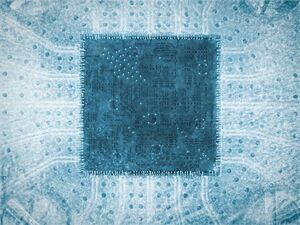
QuTech takes important step in quantum computing with error correction
"Researchers at QuTech—a collaboration between the TU Delft and TNO—have reached a milestone in quantum error correction. They have integrated high-fidelity operations on encoded quantum data with a scalable scheme for repeated data stabilization. The researchers report their findings in the December issue of Nature Physics. More qubits Physical quantum bits, or qubits, are vulnerable to errors. These errors arise from various sources, including quantum decoherence, crosstalk, and imperfect calibration. Fortunately, the theory of quantum error correction stipulates the possibility to compute while synchronously protecting quantum data from such errors." [...]

Stars' secret embraces revealed by Alma
"Unlike our Sun, most stars live with a companion. Sometimes, two come so close that one engulfs the other - with far-reaching consequences. When a Chalmers-led team of astronomers used the telescope Alma to study 15 unusual stars, they were surprised to find that they all recently underwent this phase. The discovery promises new insight on the sky's most dramatic phenomena – and on life, death and rebirth among the stars. Using the gigantic telescope Alma in Chile, a Chalmers-led team of scientists studied 15 unusual stars in our galaxy, the Milky Way, the closest 5000 light years from Earth. Their measurements show that all the stars are double, and all have recently experienced a rare phase that is poorly understood, but is believed to lead to many other astronomical phenomena. Their results are published this week in the scientific journal Nature Astronomy." [...]

Stanford engineers and physicists study quantum characteristics of ‘combs’ of light
"Frequency microcombs are specialized light sources that can function as light-based clocks, rulers and sensors to measure time, distance and molecular composition with high precision. New Stanford research presents a novel tool for investigating the quantum characteristics of these sources. Unlike the jumble of frequencies produced by the light that surrounds us in daily life, each frequency of light in a specialized light source known as a “soliton” frequency comb oscillates in unison, generating solitary pulses with consistent timing. Each “tooth” of the comb is a different color of light, spaced so precisely that this system is used to measure all manner of phenomena and characteristics. Miniaturized versions of these combs – called microcombs – that are currently in development have the potential to enhance countless technologies, including GPS systems, telecommunications, autonomous vehicles, greenhouse gas tracking, spacecraft autonomy and ultra-precise timekeeping. The lab of Stanford University electrical engineer Jelena Vučković only recently joined the microcomb community." [...]
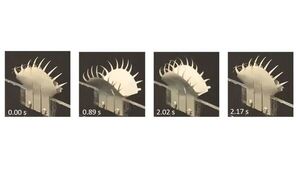
Soft robots speed up thanks to new thermal actuator design
"A new design for thermal actuators can create rapid movements in soft robotic devices. Developed at North Carolina State University, potential applications for the fast-moving parts could include prosthetic devices and high-end manufacturing machines. Actuators create motion by converting energy into work. “Using thermal actuation is not new for soft robots, but the biggest challenge for soft thermal actuators was that they were relatively slow – and we’ve made them fast,” said Professor Yong Zhu, corresponding author of the new research. “What makes this new actuator design work is a structure with a bi-stable design,” said first author Shuang Wu. “Think of a snap hair clip." [...]

Researchers probe the performance of high-temperature superconductor in new DOE-funded study
"The next generation of superconducting magnets has the potential to revolutionize fields such as energy storage, particle accelerators and medicine. The magic behind these tools lies in the high-temperature superconducting (HTS) wires that power them. A FAMU-FSU College of Engineering team has discovered how to optimize a type of HTS wire, findings that may lead to new processing techniques to improve performance and lower costs. Their work was published in Physical Review Materials. “There are three types of commercially available HTS wires that can power superconducting magnets,” said lead author Yavuz Oz, a postdoctoral researcher at the FSU-headquartered National High Magnetic Field Laboratory. “Two of these are made in rectangular form, and look like rolls of tape when wound up, and the third is round." [...]
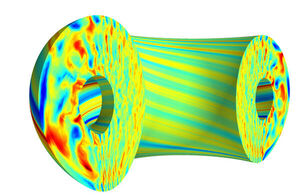
Closing In On Fusion
"A team modeled plasma turbulence on the nation’s fastest supercomputer to better understand plasma behavior The same process that fuels stars could one day be used to generate massive amounts of power here on Earth. Nuclear fusion—in which atomic nuclei fuse to form heavier nuclei and release energy in the process—promises to be a long-term, sustainable, and safe form of energy. But scientists are still trying to fine-tune the process of creating net fusion power. A team led by computational physicist Emily Belli of General Atomics has used the 200-petaflop Summit supercomputer at the Oak Ridge Leadership Computing Facility (OLCF), a US Department of Energy (DOE) Office of Science user facility at Oak Ridge National Laboratory (ORNL), to simulate energy loss in fusion plasmas. The team used Summit to model plasma turbulence, the unsteady movement of plasma, in a nuclear fusion device called a tokamak. The team’s simulations will help inform the design of next-generation fusion devices with optimum confinement properties." [...]
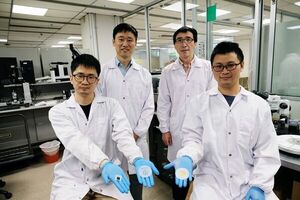
Batteries of the future could be paper-thin and biodegradable
"NTU Singapore scientists have developed paper-thin biodegradable zinc batteries that could one day become an environmentally sustainable option for powering flexible and wearable electronic systems. These zinc batteries are made up of electrodes (through which the electrical current leaves or enters the battery) screen-printed on to both sides of a piece of cellulose paper that has been reinforced with hydrogel. Once the battery has been expended, it can be buried in soil, where it breaks down completely within a month. The scientists think their printed battery could be integrated into flexible electronics such as foldable smart phones that are already on the market, or biomedical sensors for health monitoring. " [...]
Documentação
A documentação é parte essencial do processo de aprendizagem e a Internet além de artigos interessantes de explorar também tem alguma documentação em formato PDF interessante de ler. Todos os links aqui apresentados são para conteúdo disponibilizado livremente pelo editor do livro.

The MagPi 113
"- New User Guide 2022. Install Raspberry Pi OS (bullseye) and discover all the features of Raspberry Pi with our starter guide. Plus! Discover electronics, camera support, and accessories. - Build a binary clock. Use your binary skills to tell the time with this neat programming project." [...]
Projetos Maker
Diversos Projetos interessantes.
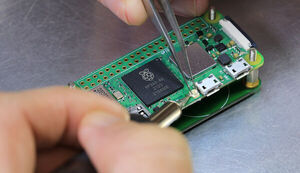
Raspberry Pi Zero 2 W external antenna mod
"The Raspberry Pi Zero 2 W is the latest board in the Raspberry Pi Zero family, with a 1GHz quad-core processor and 512MB SDRAM and was released on the 28th October 2021. When the Raspberry Pi Zero W was released in 2017 we modified the board with an external antenna connector which was a very popular blog post and with the announcement of the new Raspberry Pi Zero 2 W version we tried to order the new board and try the same modification again. Initially there was very limited stock available and we were not able to order the new board until the end of November. As with the previous version the Raspberry Pi foundation have left a PCB footprint and jumper pads for a U.FL RF connector to use with an external antenna but the new Raspberry Pi Zero 2 W has a solid PCB trance going to the built in antenna compared to the 0201 link used on the previous board. " [...]
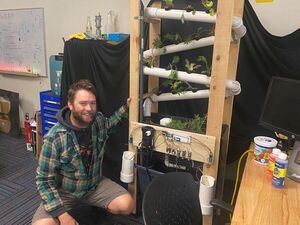
Automated Hydroponic System
"An automated system for growing plants in a hydroponic set up. Reduce water usage by automatically recycling and amending your water. Hydroponics is the practice of growing plants in water instead of soil. I have long wanted to build a small system for practicing hydroponics, and I found my IoT Bootcamp Capstone the perfect opportunity to not only build the system, but automate it as well. The first steps were in building the physical structure. I would love to build systems like this with recovered or recycled materials, but because of the time constraints from the class, I mostly used materials from Home Depot." [...]
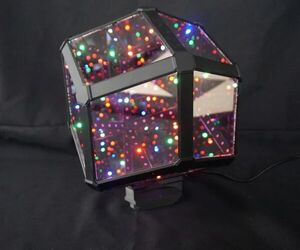
Rhombic Dodecahedron Infinity Lamp
"I wanted to add some space to my house. An infinity solid seemed like the simplest way to do this. I have been keeping an eye on infinity mirror type objects for years now. Infinity mirrors are great to see, but I never felt the urge to build one. That was until I saw the video below, where Adam Savage and Matt Parker build an infinity rhombic dodecahedron. I love the shape, and how it nests unlike the conventional dodecahedron." [...]

Homematic Display Clock
"An Arduino based self-setting clock which can display temperature and other data from Homematic systems. I used to have a cheap and inaccurate clock with temperature display in our living room which I wanted to replace with something with can set the time&date on it's own as you would expect today. Also it should display my available Homematic smart-home data such as temperature sensors and other information (e.g. door bell sensor). Since there was no such device on the market, I decided to make it myself. I decided to use the Arduino "Mkr Wifi 1010" for this project mainly for WiFi access capability and available resources." [...]

MIDI Pedal Board for guitar multieffect FX-500
"A pedal board to send MIDI Program Change to my old guitar multieffect that has a MIDI IN port. I have an old guitar multieffect Yamaha FX-500. To change the presets (90 in total), I must press up/down buttons and confirm it with another one. It is not useful while playing guitar. So I decided to create a pedalboard to change the presets quickly. In the back of the multieffect there is a MIDI IN port that can receive MIDI instructions (or for connecting the original pedalboard)." [...]

Simple Christmas Tree
"Still don't have a Christmas Tree? Don't panic! Grab an Arduino, some jumper wires and let's do it!! I saw many Arduino-based Christmas decorations. Most of them focused mainly on hiding the jumper cables as well as possible. Why do it though?" [...]

Retro Computer Console
"Build your own Raspberry Pi Zero Powered retro 1970s Cray-1 console with this simple 3d printable project. The design for project is based on the Cray-1 Supercomputer from the 1970s. I wanted to create something fun to go along with this project, so I found a photo of a console from the Cray-1 brochure of a woman using a console. I designed the console in Fusion 360, using the photo as an inspiration, and using the Hyperpixel 4.0 display as a key measurement around which everything else is based. This project is very easy to build; you'll just need the components listed, and 3d print the STL files. No glue is required, though you may need some blutac to attach the screen to the case." [...]
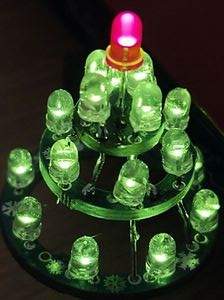
PCB Xmas tree with LEDs
"This little and fun project was created to bring smile to peoples face durig Xmas. It is USB powered, easy to make Christmas tree with minimal number of components. List of parts: - 18x GREEN 3mm, THT LED - 1x RED 3mm, THT LED - 19x 1k 0603 resistor - PCB" [...]

One Minute Punch Break
"Take a Break, Let it Out We'd probably all agree that physical release can be the most satisfying and relieving outlet when stress levels are high or a burst of adrenaline runs through our veins. The One Minute Punch Break creates a healthy space for frustrations and pent up emotions, designed to turn tension into release and then a smile. Intended to be mounted on the walls of offices and co-working spaces, the massive button starts a 60-sec LED timer while each punch you make is reflected on the counter. Is working from home driving you insane? Does your office need an anger zone? Or do you find yourself needing an outlet before a big presentation?" [...]
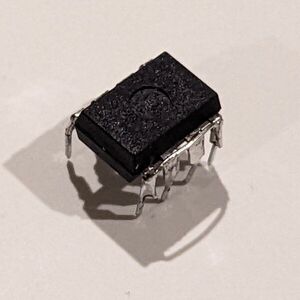
ATTiny555
"What, you're using a 555? I could've done that with a microcontroller! The ATTiny555 is a 555 timer being simulated on an ATTiny85. If you can do a microcontroller project with a 555, why can't I do a 555 project with a microcontroller? This abomination of analog and digital circuitry reared its ugly head because I was too lazy to order a 555 off of Amazon. I already had a few ATTiny85s laying around, so why not?" [...]

Bluetooth Matrix
"The project is a sample project about how matrix monitors works. The scroll speed can be set by a potentiometer. A Bluetooth module added to the project. So, you can send texts to your board with a smart phone. A 3dprinted stand designed for the PCB. So you can place your board on a table and enjoy!" [...]
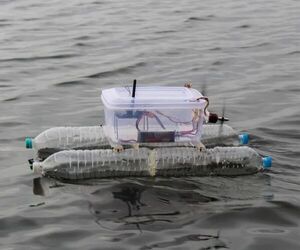
Long Range Autonomous Boat
"Recently there have been beach restoration projects in our city and instruments were required to measure the depth of the sea floor at various locations. This process turned out to be tedious and expensive due to the labor costs as well as the expensive equipment. A boat was fitted with various sensors and drove along the coast for hours. This inspired me to build a small scale autonomous boat to perform the same tasks. The boat could be fitted with the necessary sensors and programmed to drive along a desired path and collect the necessary information. The boat would also consist of a radio based telemetry system so that the health of the boat could be monitored in real time." [...]
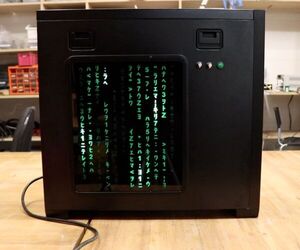
Matrix Computer Side Panel
"This project uses a PCB board with a NodeMCU ESP8266, coded to control 216 NeoPixels, to animate the side of a computer tower with the famous "raining code" animation from the Matrix franchise. The NeoPixel control board is a modular, customizable PCB breakout board for controlling multiple strips of NeoPixels with user input options to control the speed and brightness of the display with potentiometers and control the animation mode with a push button. This project does use tools like laser cutters that are not accessible to everyone, so alternative options and suggestions throughout this project such as creating a spray paint stencil with a traditional printer and also building a breadboard circuit instead of having the PCB boards fabricated via online services. The GitHub repo for this project, including the PCB Gerber files and code, is available here: https://github.com/WillDonaldson/NeoPixel_Control_Board Materials - 1x PCB (see comments in next section) - 1x NodeMCU ESP8266 - 1x 74AHCT125 chip - 2x 10K Ohm resistors - 4x 470 Ohm resistors - 2x 1N4001 diodes - 1x 1000uF electrolytic capacitor - 12x M3 20mm bolts - 1x DC barrel jack female and male connector (recommend 5A rating over the more common 2.5A rating) - 1x ON/OFF switch (optional) - 1x Momentary push button (optional) - 2x 10K Ohm potentiometers (optional) - 2x 2-pin JST-VH female and male connectors (optional) - 4x 3-pin JST-VH female and male connectors (optional) - Zipties for cable management (optional) - 5m strip of WS2812B NeoPixels (60 LEDs/meter) - 2x 40cm by 40cm sheet of black acrylic 3mm (dimensions will vary depending on you PC) - 1x 40cm by 40cm sheet of white diffusing acrylic 3mm (dimensions will vary depending on you PC)\ - Acrylic glue or super glue - Assorted electrical accessories: wire, solder, heat shrink tube - Computer with a power supply that has one 5V and GND pin available. Alternatively can bypass the inbuilt power supply and power the circuit by a traditional 5V 5Amp power supply Tools - Laser cutter (optional but recommended) - Soldering iron - Allen key for M3 bolt - Miscellaneous tools: Wire strippers, snips" [...]
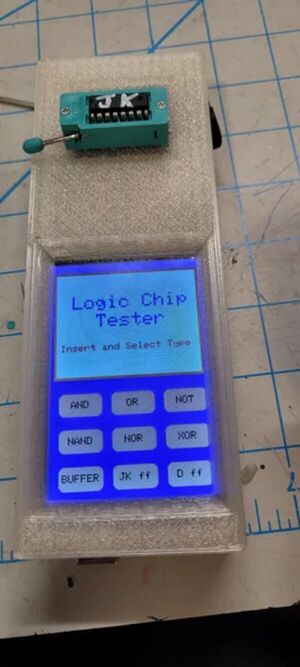
Logic Chip Tester
"This is a logic chip tester for the 7400 series of logic chips, covering the AND, OR, NOT, NAND, NOR, XOR, BUFFER, JK ff, and D ff. This was a project started by Dr. Tim Frank of Glendale Community College. The actual program is a product of Dr. Frank and two other students (Stephen Bakle and Noel Rojas), with the Dr. Frank being the main programmer. Dr. Frank also designed the circuit board labeled "Socket Board" using Eagle CAD. With his permission both the code and the artwork for the board are being published and included in this Instructable. Before I transferred to ASU I was asked to help develop a case for the chip tester due to my experience in modeling software and the case has evolved several times." [...]

Balancing Robot / 3 Wheel Robot / STEM Robot
"We have built a combined balancing and 3 wheel robot for edcuational use in schools and after school educational programmes. The robot is based on an Arduino Uno, a custom shield (all construction details provided), a Li Ion battery pack (all construction details provided) or a 6xAA battery pack, a MPU 6050, a BLE bluetooth module, an ultrasonic module (optional) and a servo to move an arm. There are also extensive education material available ready for use in class rooms. The attached document is the instructions given to kids to build the robot in a series of steps which provide educational learning at each step. There are 7 exercises which can be done before the full balaning / 3 wheel robot sketch is uploaded. Each of the exercises focus on a particular aspect of the robot, e.g." [...]
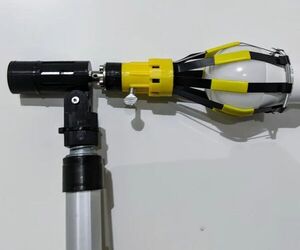
Motorized Light Bulb Changer
"Do you have hard-to-reach light bulbs? If so, then you are perhaps familiar with a device known as a Light Bulb Changer. It threads on the end of a pole and extends your reach. A problem is one of mechanics. If you can't get your pole square to the bulb, the effectiveness of the holder decreases rapidly. Imagine trying to use this thing at a 90 degree angle to the bulb." [...]
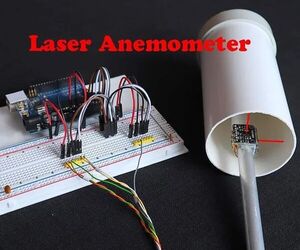
Laser Anemometer
"This instructable explains how to make an anemometer from an Arduino Uno R3, two VL6180X laser distance modules, and a section of plastic drain pipe or similar. Processing3 is used to display the wind speed and wind direction. The wind direction is independent of the pipe dimensions. The sensitivity to wind speed depends on the pipe dimensions and the amount of applied damping. Construction is simple ... all you need is a drill , a hacksaw, and a hot-glue gun. The anemometer is purely experimental and is published in the hope that the techniques will be of use to others." [...]
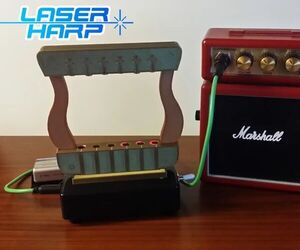
Build a Laser Harp From Scratch
"This is actually a really simple circuit, using just one hex-inverter chip and a handful of small, common components. Discover step-by-step how this circuit works by building it on breadboard first with a detailed guide. Finally, build the finished instrument, tune it and play! Supplies - Breadboard + jumper wires - 1 piece 37x24 stripboard - CD40106 IC x1 - 2N5457 x6 - 2N3904 x6 - Laser LED x6 - LDR x6 - 10k Trim pot x6 - 1k resistors x18 - 100k resistors x12 - 100nF capacitors x6 - 470nF capacitors x6 - Coloured wire (28AWG) - 3.5mm jack socket - 5.5mm DC jack socket - Toggle switch - 3mm Threaded Inserts x4 - M3 20mm nylon spacers & screws x2 - M3 Screws x6 - Plastic project box 100mm x 60mm x 25mm - Amplifier or powered PC speakers + jack lead" [...]
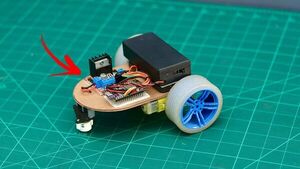
Make smartphone controlled Car Using Esp8266
"Hi friends, welcome back today in this article we will show you How to Make smartphone controlled Car Using Esp8266. this wifi control car control with NodeMCU This is a great project for School science project model or those who do not yet know what Esp8266 is and want to make their first robot. Supplies: - ESP8266 - Wheels - TT Gear Motor - 18650 Li-Po Battery - 18650 Battery Holder - Jumper Wires - MDF wood" [...]
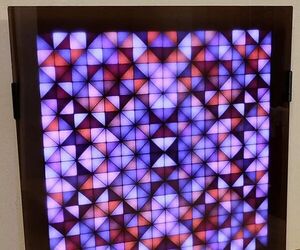
Tetrakis Square Tiling With WS2812 LEDs
"I hope the title is weird enough that you will want to know what my project is about :) Firstly, a few words about tilling or tessellation. The tilling (or tessellation) consists of the division of the Euclidean 2D plane with the help of some geometric figures, the condition being that between these figures there is no gap but also no overlapping. There may be regular tessellations, obtained by repeating the same geometric figures but also semi-regular in the case of tessellations with several types of geometric figures. Here the difference between tiling and tessellation can be established. The tiling is done with the same geometric figure but the tessellation is made with several geometric figures. For example, a regular tiling known to nature is the honeycombs of bees, using regular hexagons and a very common tessellation is the combination of triangles and squares found in different floor mosaics." [...]
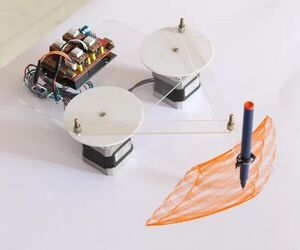
Arduino Powered Pattern Making Machine
"Mathematical relations and patterns are found all around us in our daily lives as well as in nature. These patterns can range from simple to complicated and harmonious to chaotic. No matter what type of pattern we encounter, these geometric figures have intrigued so much that and we have developed a fond appreciation of the underlying mathematics behind these. In this project we hope to develop a machine to make beautiful patterns and discover the relation between mathematics and art through patterns. We will also discover how wildly different some figures can be by barely modifying the initial parameters of the system. Follow on to create your own Arduino Powered Pattern Making Machine and do drop a favorite and follow this page if you enjoyed the project and decide to build your own version." [...]
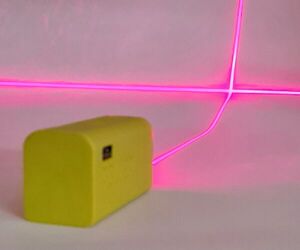
LASERINO - Easy No Fuss Laser Levelling Tool
"Hello beautiful humans, I present to you LASERINO, the simple laser leveling tool. It requires no Arduino and is super easy to assemble. Why did I build it? >> I'm too cheap to buy one of those fancy ones you see online, and I had a few lasers leftovers from a previous project. The enclosure has spaces to hold the laser holder, one Li-Ion 18650 battery, a switch, and a TP4056 charging module. For those that don't have a 3D printer, you can still build this project using Kapton tape or any electrical tape of your choice." [...]
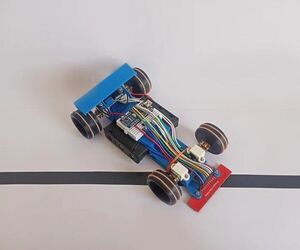
4 Wheel Drive Line Follower Robot
"Line follower robot are one of the classic project for a robotic enthusiast with self balancing and obstacle avoidance robots. It helps to get acquainted with IR sensors, motor drivers, conditional statements and PID controllers. So let's build a line follower robot giving it a spicy touch by making the robot more advance and including 4 wheel drive. The basic idea is to make the build look more like a F1 car with as possible as low ground clearance. The chassis The chassis will be made up of two major parts - one rear and other front. Both of them will be connected in the middle portion using nuts and bolts." [...]
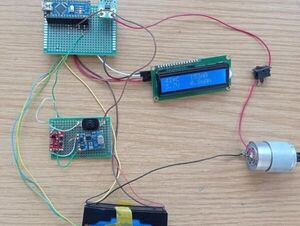
Li-Ion battery measurement system
"Hardware and software for voltage, current, capacity and temperature measurements of Li-Ion battery. The aim of this work was to realize a circuit that will measure voltage, discharge current, temperature and capacity of the Li-ion batteries, display them on the LCD screen and with software serial connections, using another microcontroller, on a remote computer. In order for the circuit to work independently, it was necessary to provide power to the Arduino Nano microcontroller with battery using a voltage regulator, to provide the required voltage of 5 V. In case the battery is discharged, we provide it with a charger for Li-ion batteries with protection to ensure that the battery will not be overcharged, and with that we have ensured the safety of the assembly itself. For voltage measurement, we used voltage divider with two resistors with a value of 10 kΩ. The Hall sensor is used to measure the current that through the consumer, the DC motor. The LM35 sensor is a temperature sensor that we use to measure the temperature of the battery." [...]

Pip-Boy 2040 Wrist-Mounted Prop
"Prep your wrist for the apocalypse! Build your own small form-factor, Fallout-inspired Pip-Boy with Feather RP2040 and CircuitPython. You can make this prop wrist-computer for cosplay, or for general stylishness all the time. Swap graphic screens on the beautiful round rectangle IPS TFT display with the directional buttons, move the cursor with the joystick, look rad. The demo code is a simple slide-show with navigation controls, but the platform can be used to code your own unique device behavior. " [...]

Sensor comparison: temperature, humidity and air pressure
"How well, or how differently, do different sensors measure environmental data? A comparison of two units under different conditions. Reliable data for temperature and humidity Environmental data can be very helpful, but for that they should also be reliable. Room temperature and humidity, for example, affect not only our health and well-being, but also the preservation and structure of the building and furniture. That's why thermo-hygrometers are becoming increasingly popular. But if the instrument shows wrong values, then it can be bad not only for health, but also the structure of the building." [...]
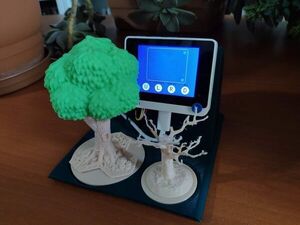
Irrigation Level Assessment by Thermal Imaging w/ TensorFlow
"Collect irrigation level data by thermal imaging, build and train a neural network model, and run the model directly on Wio Terminal. Since global temperatures are expected to rise over the next few decades due to climate change and thus evaporation rates will increase, water scarcity and the expansion of arid regions threaten productive agricultural areas and long-term water availability. Considering water availability is already limited, we need to desist from profligate water utilization in agriculture to sustain our meager water resources. Otherwise, we will encounter more critical predicaments than depleting arable lands due to water scarcity and deficiency. Since there is already an imbalance between the irrigation demand and the available water resources[1], it is crucial to avoid poor irrigation timing and insufficient or extravagant applications of water, which are unfortunately rife in agriculture. To sustain irrigated agriculture and maximize the quality of the product and the estimated crop yield while optimizing the quantity of water used per unit area[2], we need to apply precise irrigation scheduling methods." [...]
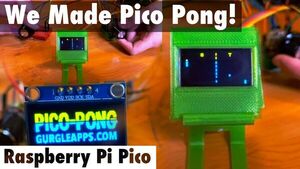
Pico-Pong
"Classic Pong On a RP2040 You only really need an SSD1306 which are cheap and easy to pick up and a couple of cheap potentiometers. You can add a speaker if you like but it will work without. " [...]
Secção Videos
Videos interessantes.
That's all Folks!



